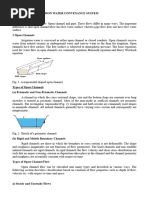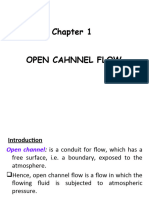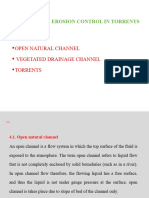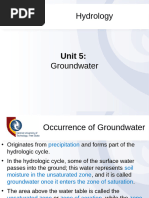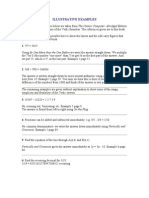BFC 21103 Hydraulics: Learning Outcomes
Uploaded by
hibby_tomeyBFC 21103 Hydraulics: Learning Outcomes
Uploaded by
hibby_tomeyBFC 21103 Hydraulics
Section 4 Instructor: Tan Lai Wai (Office: D1-309)
Lecture:
Mondays, 3 pm to 5 pm Wednesdays, 8 am to 10 am
Chapter 1. Flow in Open Channel
Learning Outcomes: 1. Differentiate between open channel flow and pipe flow 2. Define and explain on the types of flow 3. Identify the state of flow and flow regimes 4. Define open channel geometries
Chapter 1. Flow in Open Channel
Tahan river rapids
Stormwater Management and Road Tunnel (SMART), Kuala Lumpur, Malaysia Siberian meandering river
Open channel flow is flow of a liquid in a conduit with a free surface subjected to atmospheric pressure.
y
Free surface T
Flow
x Datum
Figure. Sketch of open channel geometry
Examples: flow of water in rivers, canals, partially full sewers and drains and flow of water over land.
Practical applications are the determination of: a. flow depth in rivers, canals and other conveyance conduits, b. changes in flow depth due to channel controls e.g. weirs, spillways, and gates, c. changes in river stage during floods, d. surface runoff from rainfall over land, e. optimal channel design, and f. others
1.1 Flow Parameters and Geometric Elements
a. Depth of flow y is the vertical measure of water depth. Normal depth d is measured normal to the channel bottom. d = y cos For most applications, d y when 10%. cos 0.1 = 0.995.
Flow Q y d
Free surface Sw = water surface slope
So = bottom slope
x Datum
b. Flow or discharge Q is the volume of fluid passing a cross-section perpendicular to the direction of flow per unit time. Mean velocity V is the discharge divided by the cross-sectional area V =
Q A
1.1 Geometric Elements
c. Wetted perimeter P is the length of channel perimeter that is wetted or covered by flowing water.
T = top width A = cross sectional area covered by flowing water
A P
B = bottom width
1.1 Geometric Elements
d. Hydraulic radius R is the ratio of the flow area A to wetted perimeter P. A R= P e. Hydraulic depth D is the average depth of irregular cross section.
D=
flow area A = top width T
A P B
Table. Open channel geometries Channel shape
T y B Rectangular T
2y 1 + z 2
Area A
Top width T
Wetted perimeter P
By
B + 2y
zy2
2zy
z Triangular T
1 B Trapezoidal T D 2 Circle y z y By + zy2 B + 2zy B + 2y 1 + z 2
D2 (2 sin ) 8
Dsin
1.2 Types of Open Channel
Prismatic and non-prismatic channels
Prismatic channel is the channel which cross-sectional shape, size and bottom slope are constant. Most of the man-made (artificial) channels are prismatic channels over long stretches. Examples of man-made channels are irrigation canal, flume, drainage ditches, roadside gutters, drop, chute, culvert and tunnel. All natural channels generally have varying cross-sections and therefore are non-prismatic. Examples of natural channels are tiny hillside rivulets, through brooks, streams, rivers and tidal estuaries.
Rigid and mobile boundary channels
Rigid channels are channels with boundaries that is not deformable. Channel geometry and roughness are constant over time. Typical examples are lined canals, sewers and non-erodible unlined canals. Mobile boundary channels are channels with boundaries that undergo deformation due to the continuous process of erosion and deposition due to the flow. Examples are unlined man-made channels and natural rivers.
Canals - is usually a long and mild-sloped channel built in the ground, which may be unlined or lined with stoned masonry, concrete, cement, wood or bituminous material.
Terusan Wan Muhammad Saman, Kedah
Griboyedov Canal, St. Petersburg, Russia
Flumes - is a channel of wood, metal, concrete, or masonry, usually supported on or above the surface of the ground to carry water across a depression.
This flume diverts water from White River, Washington to generate electricity
Bull Run Hydroelectric Project diversion flume
Open-channel flume in laboratory
Chute -
is a channel having steep slopes.
Natural chute (falls) on the left and man-made logging chute on the right on the Coulonge River, Quebec, Canada
Drop - is similar to a chute, but the change in elevation is within a short distance.
The spillway of Leasburg Diversion Dam is a vertical hard basin drop structure designed to dissipate energy
Stormwater sewer - is a drain or drain system designed to drain excess rain from paved streets, parkinglots, sidewalks and roofs.
Storm drain receiving urban runoff
Storm sewer
1.3 Types / Classification of Open Channel Flows
Open channel flow conditions can be characterised with respect to space (uniform or non-uniform flows) and time (steady or unsteady flows).
Space - how do the flow conditions change along the reach of an open channel system. a. Uniform flow - depth of flow is the same at every section of the flow dy/dx = 0 b. Non-uniform flow - depth of flow varies along the flow dy/dx 0
Time - how do the flow conditions change over time at a specific section in an open channel system. c. Steady flow - depth of flow does not change/ constant during the time interval under consideration dy/dt = 0 d. Unsteady flow - depth of flow changes with time dy/dt 0
1.3 Types / Classification of Open Channel Flows
a. Uniform flow
y y Const ant water
depth
b. Non-uniform flow
y1 y2
Depth change s along the chan nel
c. Steady flow
y Time = t1 y Time = t2 t3 t1 t2 y1 Time = t1 t3 t1 t2 y1 Time = t2
d. Unsteady flow
y y
Open channel flow
Steady flow
Unsteady flow
Uniform flow
Non-uniform flow
Rapidly-varied flow
Gradually-varied flow
Various types of open-channel flow
The flow is rapidly varied if the depth changes abruptly over a comparatively short distance. Examples of rapidly varied flow (RVF) are hydraulic jump, hydraulic drop, flow over weir and flow under a sluice gate. The flow is gradually varied if the depth changes slowly over a comparatively long distance. Examples of gradually varied flow (GVF) are flow over a mild slope and the backing up of flow (backwater).
RVF GVF RVF
GVF
RVF
GVF
RVF
Sluice
Hydraulic jump
Flow over weir Hydraulic drop
Contraction below the sluice
1.4 State of Flow
The state or behaviour of open-channel flow is governed basically by the viscosity and gravity effects relative to the inertial forces of the flow.
Effect of viscosity - depending on the effect of viscosity relative to inertial forces, the flow may be in laminar, turbulent, or transitional state.
- Reynolds number represents the effect of viscosity relative to inertia, VR Re = where V is the velocity, R is the hydraulic radius of a conduit and is the kinematic viscosity (for water at 20C, = 1.004 106 m2/s, dynamic viscosity = 1.002 103 Ns/m2 and density = 998.2 kg/m3). Re < 500 , the flow is laminar
500 < Re < 12500, the flow is transitional Re > 12500 , the flow is turbulent
Re < 500
Re = VR
, the flow is laminar
500 < Re < 12500, the flow is transitional Re > 12500 , the flow is turbulent
The flow is laminar if the viscous forces are dominant relative to inertia. Viscosity will determine the flow behaviour. In laminar flow, water particles move in definite smooth paths.
The flow is turbulent if the inertial forces are dominant than the viscous force. In turbulent flow, water particles move in irregular paths which are not smooth.
10
1.4 State of Flow
Effect of gravity
- depending on the effect of gravity forces relative to inertial forces, the flow may be subcritical, critical and supercritical. - Froude number represents the ratio of inertial forces to gravity forces, V Fr = gD where V is the velocity, D is the hydraulic depth of a conduit and g is the gravity acceleration (g = 9.81 m/s2).
Fr < 1 Fr = 1 Fr > 1
, the flow is in subcritical state , the flow is in critical state , the flow is in supercritical state
V < gD V = gD V > gD
11
1.5 Regimes of Flow
A combined effect of viscosity and gravity may produce any one of the following four regimes of flow in an open channel: a. subcritical - laminar b. supercritical - laminar , when Fr < 1 and Re < 500 , when Fr > 1 and Re < 500
c. supercritical - turbulent , when Fr > 1 and Re > 12500 d. subcritical - turbulent , when Fr < 1 and Re > 12500
Assignment No. 1 (due date September 21, 2011)
Q1. [Final Exam Sem. 1, Session 2010/2011] Justify the difference between: (a) uniform flow and nonuniform flow (b) state of flow using Reynolds number Re and Froude number Fr Q2. [Final Exam Sem. 1, Session 2008/2009] (a) What is: (i) Wetted perimeter (ii) Gradually varied flow (iii) Non-uniform flow (iv) Froude number (b) Explain the differences between canal and sewer.
12
Q3. [Final Exam Sem. 1, Session 2006/2007] What is: (a) Reynolds number (b) Froude number (c) Hydraulic radius (d) Prismatic channel (e) Uniform flow
Q4. A discharge of 16.0 m3/s flows with a depth of 2.0 m in a rectangular channel of 4.0 m wide. Determine the state of flow based on (i) Froude number, and (ii) Reynolds number. Determine the flow regime. Q5. A triangular channel of apex angle 120 carries a discharge of 1573 L/s. Calculate the critical depth.
13
You might also like
- Multigas Instrument 1438382546BH-4A 英文说明书No ratings yetMultigas Instrument 1438382546BH-4A 英文说明书13 pages
- Prepared By: ER Lapong: MSU-General Santos100% (2)Prepared By: ER Lapong: MSU-General Santos59 pages
- 2... Extra Work - HYDRAULICS Flow in PipesNo ratings yet2... Extra Work - HYDRAULICS Flow in Pipes55 pages
- Hydraulics Topic 1 Flow in Open ChannelNo ratings yetHydraulics Topic 1 Flow in Open Channel41 pages
- OPEN CHANNELS Lecture Notes 2024 Chapter 1[1]No ratings yetOPEN CHANNELS Lecture Notes 2024 Chapter 1[1]20 pages
- 1_Introduction_to_Open_Channel_Hydraulics-1No ratings yet1_Introduction_to_Open_Channel_Hydraulics-17 pages
- Chapter 1. Flow in Open Channel: BFC21103 HydraulicsNo ratings yetChapter 1. Flow in Open Channel: BFC21103 Hydraulics41 pages
- Chapt 1 Introduction and Review of HydraulicsNo ratings yetChapt 1 Introduction and Review of Hydraulics86 pages
- SI. No. Page No.: Uniform Flow in Open ChannelNo ratings yetSI. No. Page No.: Uniform Flow in Open Channel163 pages
- Central Luzon State University: Module 4: Page 1 of 40100% (1)Central Luzon State University: Module 4: Page 1 of 4040 pages
- HTO: Toronto's Water from Lake Iroquois to Lost Rivers and Low-flow ToiletsFrom EverandHTO: Toronto's Water from Lake Iroquois to Lost Rivers and Low-flow ToiletsChristina PalassioNo ratings yet
- 4.1 Fire Safety Rules & Regulations 4.2 Passive Fire ProtectionNo ratings yet4.1 Fire Safety Rules & Regulations 4.2 Passive Fire Protection42 pages
- Stephanie Paladino (Editor), Shirley J Fiske (Editor) - The Carbon Fix - Forest Carbon, Social Justice, and Environmental Governance-Routledge (2016)No ratings yetStephanie Paladino (Editor), Shirley J Fiske (Editor) - The Carbon Fix - Forest Carbon, Social Justice, and Environmental Governance-Routledge (2016)356 pages
- Customizable Backlyte: Date Notes ProjectNo ratings yetCustomizable Backlyte: Date Notes Project2 pages
- Classification and Identification of Mosquitoes of New MexicoNo ratings yetClassification and Identification of Mosquitoes of New Mexico7 pages
- Pediatrics PreTest Self Assessment and Review Twelfth Edition Robert Yetman - The ebook in PDF format is ready for immediate access100% (1)Pediatrics PreTest Self Assessment and Review Twelfth Edition Robert Yetman - The ebook in PDF format is ready for immediate access50 pages
- MDCT: Technical Principles and Future Trends: Mathias ProkopNo ratings yetMDCT: Technical Principles and Future Trends: Mathias Prokop8 pages
- Handbook of Hydrophone Element Design TechnologyNo ratings yetHandbook of Hydrophone Element Design Technology2 pages
- 2 Medical Demography Dynamic & Composition-1No ratings yet2 Medical Demography Dynamic & Composition-167 pages
- Step by Step Guidebook HFMEA January2021No ratings yetStep by Step Guidebook HFMEA January202123 pages
- Mark Hyman - The Young Forever Cookbook (2024) - Libgen - LiNo ratings yetMark Hyman - The Young Forever Cookbook (2024) - Libgen - Li332 pages
- Wavelet Applications in Economics and Finance (PDFDrive)100% (1)Wavelet Applications in Economics and Finance (PDFDrive)271 pages
- Active Structural Control: Abstract This Chapter Provides An Overview of Building Structure Modeling andNo ratings yetActive Structural Control: Abstract This Chapter Provides An Overview of Building Structure Modeling and37 pages
- Illustrative Examples of Vedic MathematicsNo ratings yetIllustrative Examples of Vedic Mathematics3 pages
- Chapter 1. Flow in Open Channel: BFC21103 HydraulicsChapter 1. Flow in Open Channel: BFC21103 Hydraulics
- Central Luzon State University: Module 4: Page 1 of 40Central Luzon State University: Module 4: Page 1 of 40
- HTO: Toronto's Water from Lake Iroquois to Lost Rivers and Low-flow ToiletsFrom EverandHTO: Toronto's Water from Lake Iroquois to Lost Rivers and Low-flow Toilets
- 4.1 Fire Safety Rules & Regulations 4.2 Passive Fire Protection4.1 Fire Safety Rules & Regulations 4.2 Passive Fire Protection
- Stephanie Paladino (Editor), Shirley J Fiske (Editor) - The Carbon Fix - Forest Carbon, Social Justice, and Environmental Governance-Routledge (2016)Stephanie Paladino (Editor), Shirley J Fiske (Editor) - The Carbon Fix - Forest Carbon, Social Justice, and Environmental Governance-Routledge (2016)
- Classification and Identification of Mosquitoes of New MexicoClassification and Identification of Mosquitoes of New Mexico
- Pediatrics PreTest Self Assessment and Review Twelfth Edition Robert Yetman - The ebook in PDF format is ready for immediate accessPediatrics PreTest Self Assessment and Review Twelfth Edition Robert Yetman - The ebook in PDF format is ready for immediate access
- MDCT: Technical Principles and Future Trends: Mathias ProkopMDCT: Technical Principles and Future Trends: Mathias Prokop
- Mark Hyman - The Young Forever Cookbook (2024) - Libgen - LiMark Hyman - The Young Forever Cookbook (2024) - Libgen - Li
- Wavelet Applications in Economics and Finance (PDFDrive)Wavelet Applications in Economics and Finance (PDFDrive)
- Active Structural Control: Abstract This Chapter Provides An Overview of Building Structure Modeling andActive Structural Control: Abstract This Chapter Provides An Overview of Building Structure Modeling and












